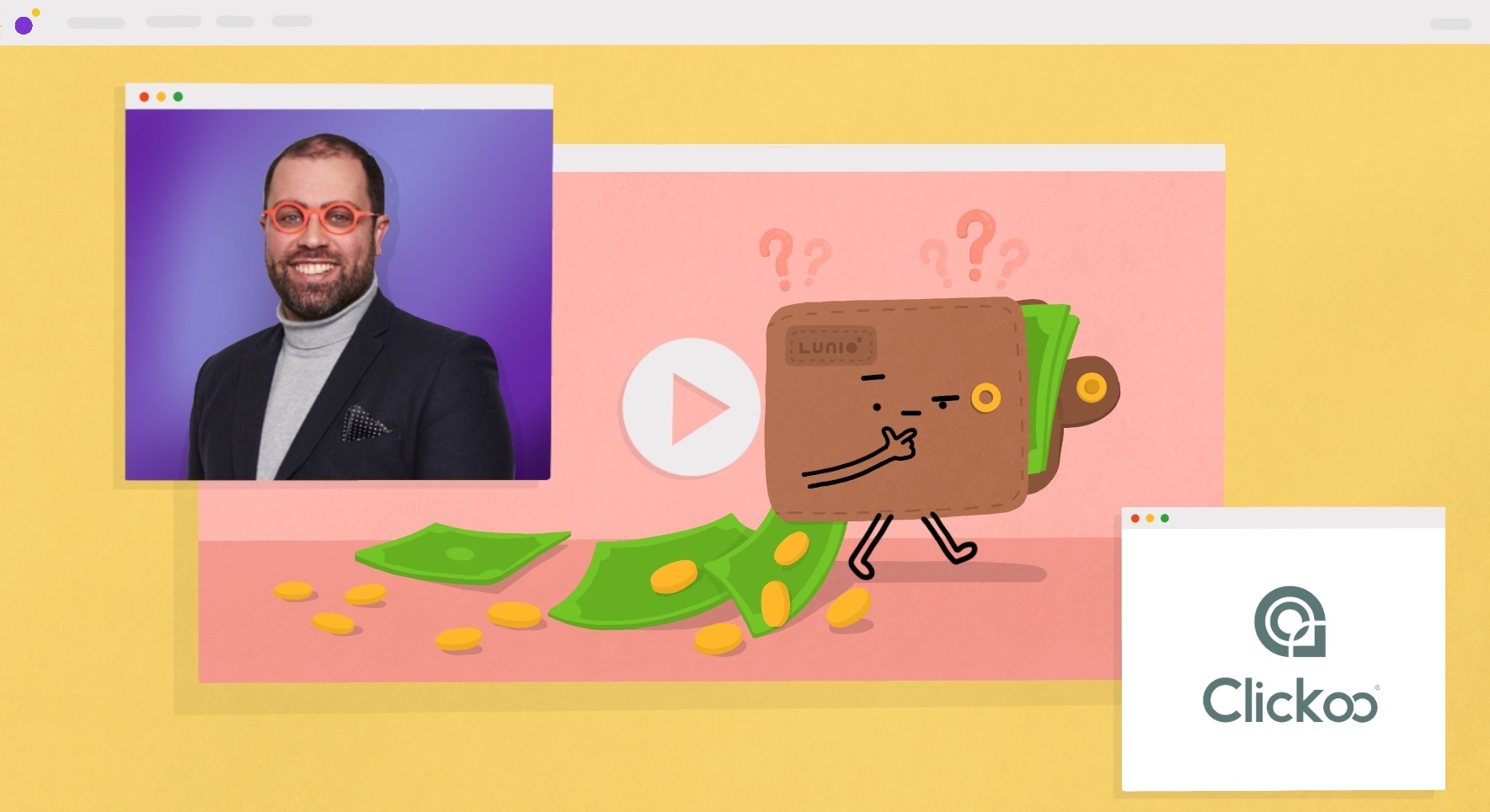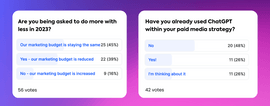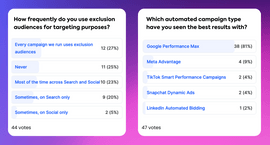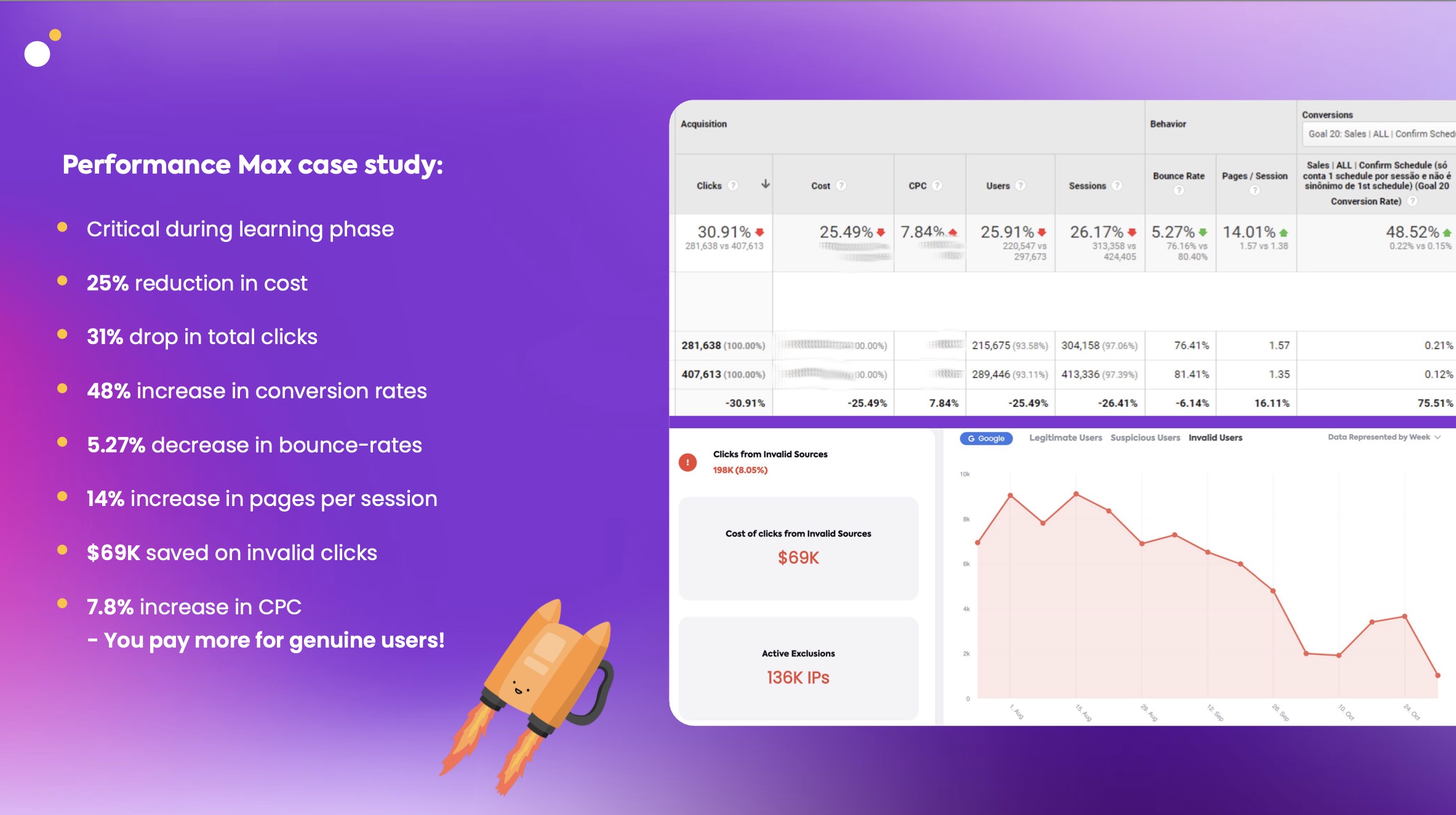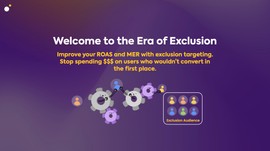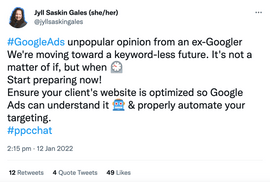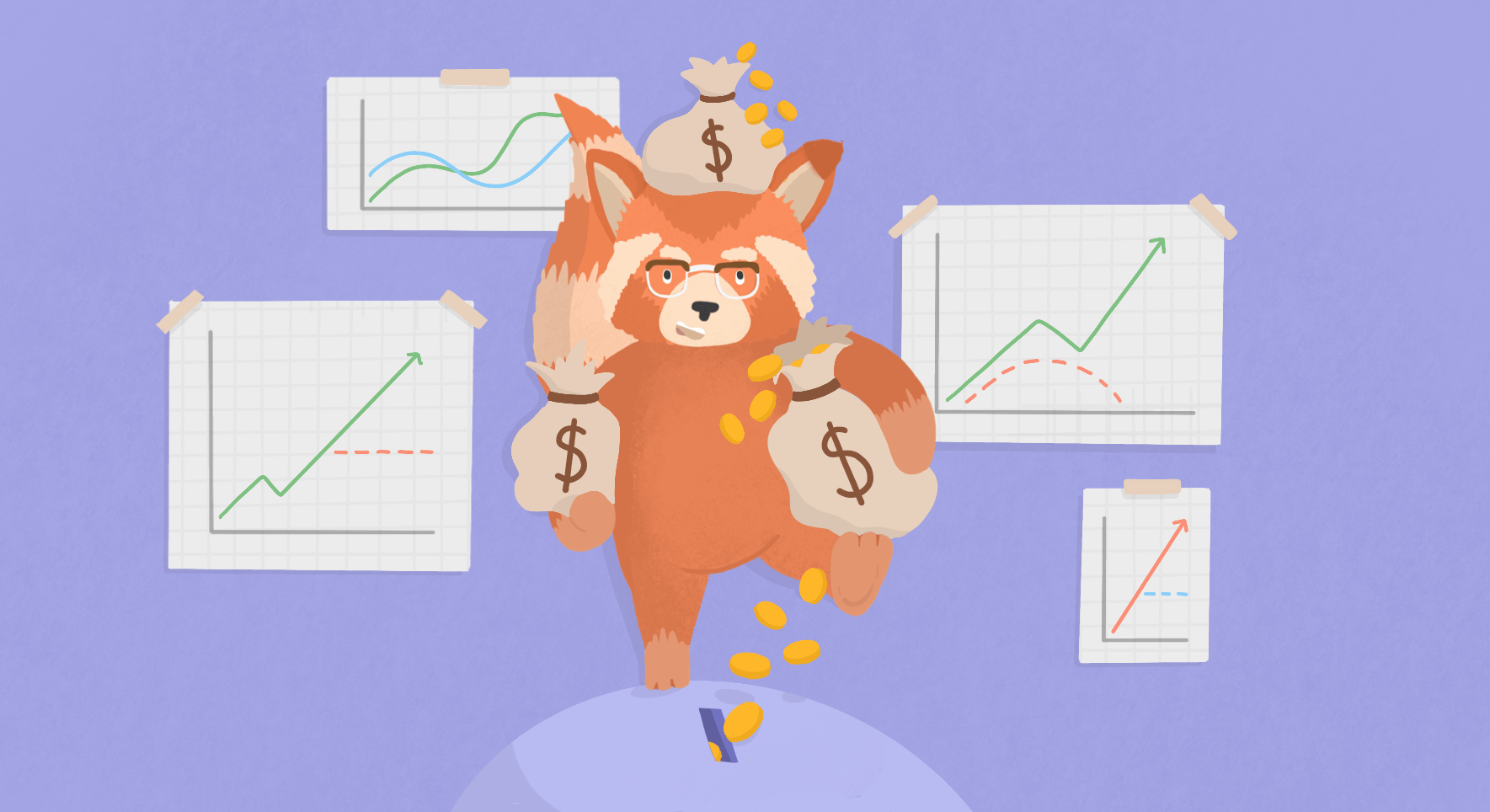In the current economic climate, ad spend optimisation matters more than ever. The brands that get it right will surf through the ongoing wave of disruption, while those that don’t will struggle to stay afloat. So what processes, practices, and technologies can you put in place to ensure 100% of your PPC budget is used wisely in 2023?
In our latest webinar, we spoke to Gareth Westhead, Head of Paid Media at Clickoo about how to identify and eliminate inefficiencies from your PPC strategy. Gareth was joined by Leonardo Pizzaro, Head of Demand Generation at Lunio, and the conversation was hosted by Lunio’s Content Manager, James Deeney.
Gareth has more than 15 years of B2C and B2B advertising experience, with an emphasis on using data to guide marketing spend and campaign decision-making. Listen to the conversation or read the summary below to learn how to extract as much value as possible from your paid marketing channels.
Webinar Timestamps
- 00:00 – Intro & agenda
- 04:45 – Can you “do more with less” in paid media?
- 14:09 – Common causes of wasted ad spend (and how to fix them)
- 26:40 – Benefits of eliminating invalid traffic and fake ad engagements
- 31:50 – How to use exclusion targeting to improve ROAS
- 34:30 – Paid media tends for 2023 (including ChatGPT)
Note: If you’re interested in ChatGPT prompts you can use for PCC, use the contents table on the left to skip ahead to the “Benefits & Risks of ChatGPT for PPC” section at the end of this article.
TL;DR – Key Takeaways
- If working with a reduced budget, interrogate your historical performance data to get a firm grasp on where your marketing spend has previously delivered and where it hasn’t. Work out key metrics for each channel and campaign such as profitability, revenue, average order value, cost per lead / cost per sale.
- Look at the performance of individual ad groups to determine the most promoting growth areas (e.g. TikTok) that warrant further investment.
- Avoid the temptation to eliminate spending on less directly-attributable marketing activity like organic social and SEO. Short term savings will give way to a gradual dip in performance over three to six months.
- If your overall sales volume and business growth (i.e. marketing effectiveness) is too low, review the imagery, ad copy, and overall messaging you’re using.
- If your campaign ROAS (i.e. marketing efficiency) is too low look further into conversion rate optimisation to get more value out of the traffic you’re already paying for.
- Calculate your Marketing Efficiency Ratio (total paid media spend / total revenue from paid media) to give a holistic view of your performance. If you only focus on ROAS at campaign level, you can lose sight of how certain channels are influencing your results.
- Make sure you’re tracking all Primary (e.g. direct sales) and Secondary (e.g. newsletter signups) conversions that are important to your business.
- If you haven’t already, move away from third-party cookie retargeting and use existing customer data to target similar people based on behaviours, values, and outlook on life.
- Regularly audit your conversion tracking setup to ensure everything is working as it should, especially if your website is continually evolving.
- Exclude branded search terms from your PMax campaigns and catch them in a separate Shopping campaign instead. This prevents your PMax campaigns from becoming contaminated with conversion data that will lead the algorithms astray.
- Is using PMax for B2B, do so primarily to drive upper funnel lead gen activity. Use standard search to catch bottom-of-funnel conversions.
- Add your own PMax videos or Google will create yours (and they suck). Use Ads Creative Studio to make your own videos or work with a freelancer from Upwork to create them for you at relatively low-cost.
- 10 – 20% of ad spend is typically wasted on bots and fake users on social platforms. By eliminating invalid activity from your campaigns, the money saved can be reinvested to reduce your cost per lead and drive greater overall conversion volume.
- Make extensive use of exclusion targeting on both Search & Social to eliminate non-converting audiences and drive further ad spend optimisation. For example, you can exclude inactive users on social platforms who don’t have a complete profile, haven’t posted in the last 90 days, or aren’t part of any active groups.
- Use ChatGPT to speed up tasks like keyword research, audience profiling, and ad copy creation. But do so with caution – always review and edit outputs to avoid publishing copy that looks like everyone else’s.
Audience Poll Results
During the live webinar, we ran audience survey polls of the PPC professionals in attendance. The results of each are documented below. How do your answers compare?
Can You “Do More With Less” In Paid Media?
Pretty much every business is currently taking a closer look at their spending to identify any areas where they can make cost-savings or efficiency improvements. And marketing teams are feeling the impact of that. So we asked Gareth if it’s really possible to “do more with less” in PPC and digital advertising?
“I’ve been asked this question a lot over my career. And this year some companies are having to cope with reduced headcount on top of a reduced budget, which can understandably induce panic. But if you’ve got a good data set of historical PPC performance to work with, there are certainly options available to you. In particular you can bring in new technologies to enhance what your people can do, because they are still your most important asset. It’s about finding ways to expand your capabilities while working with a reduced budget.
“The first step is building a very clear understanding of your performance to date. You essentially want to work out where your budget has previously delivered and where it hasn’t. Going ahead without a clear grasp on this is like swimming in the dark”
As a starting point, Gareth recommends interrogating your data to get a clear picture of metrics such as:
- Profitability
- Revenue
- Average order value
- Cost per lead / cost per sale
“Once you’ve got a handle on these metrics, then ask – what does PPC specifically need to succeed? Is it a specific number of new customers? Is it a profit margin? Is it a revenue number? Is it a certain cost per cost per sale or cost per lead target?
“When you know what your unique version of success looks like, you can then overlay your new budget to create a forecast. By working with your historical performance metrics, you can invest X amount into upcoming PPC campaigns and reasonably expect Y to come out at the bottom” said Gareth.
Following the steps above will help you set a top-level direction for your marketing spend. But you can identify further areas for improvement by getting more granular.
“Look at the performance of individual ad networks and ad groups. This can help you figure out where the growth areas will be. For example TikTok might be performing much less than Google Ads currently, but it could be a really good growth area that warrants continued investment” said Gareth.
If you are in a position where you have to make cutbacks, Gareth stressed the importance of keeping sight of the bigger picture that sits outside of PPC.
“If you stop investing in brand activity on social and SEO you can obviously save money in the short term. But you’ll likely see a dip in performance three to six months down the line. In certain circumstances I’ve seen those kinds of cutbacks do irreparable damage to revenue growth”
Marketing Efficiency vs Marketing Effectiveness
Marketing efficiency and marketing effectiveness are completely interdependent. So they should always be discussed together. But it’s important to understand how to assess each one and determine a course of action if things aren’t performing as intended.
Marketing effectiveness metrics include thing like:
- Sales volume
- Business growth
- Awareness
- Engagement rates
“These are top level measures of success. If these are low you need to look at the imagery, ad copy, and overall messaging you’re using” said Gareth.
On the other hand marketing efficiency metrics include:
- Cost per sale
- Cost per lead
- ROAS
- Time to close (for B2B brands)
“If these are low you need to look further into conversion rate optimisation to get more value out of the traffic you’re paying for” said Gareth.
But as mentioned previously, you can’t look at either of these in isolation.
“There is no point in focusing on marketing effectiveness and driving a huge increase in sales volume if it’s not profitable enough to cover all your costs and overheads. Likewise, there’s no point narrowing in on marketing efficiency to eke out incremental improvement in ROAS if your total sales volume is too low. You need a balance” said Gareth.
When we hear the word efficiency, we immediately think of reducing costs. But as Leo pointed out that isn’t always the case. You can become more efficient while increasing marketing spend by ensuring your campaigns are seeing higher profitability ratios over time.
“That’s why it makes sense to focus on the Marketing Efficiency Ratio (MER). It provides a way of measuring the overall ROAS of all your marketing campaigns combined.”
If you only focus on ROAS at the campaign level, you can lose sight of how certain channels are influencing your marketing performance. Just because it’s hard to directly attribute revenue to a particular marketing activity, doesn’t mean that it has no impact” said Leo.
Let’s say you use Facebook ads, Instagram ads, and Reddit ads to sell your product. Here’s how your ROAS looks after a six-month campaign:
| Channel | Ad spend | Revenue | ROAS |
| £1,000 | £10,000 | 10 | |
| £1,000 | £5,000 | 5 | |
| £1,000 | 0 | 0 | |
| Total (MER) | £3,000 | £15,000 | 5 |
Your MER – 5x – tells you this is a successful strategy. But based on your ROAS, you decide to cut Reddit from your paid media strategy, since it’s not making you any money directly.
You relaunch the campaign without Reddit. Another six months later, here are the results:
| Channel | Ad spend | Revenue | ROAS |
| £1,000 | £5,000 | 5 | |
| £1,000 | £2,000 | 2 | |
| Total (MER) | £2,000 | £7,000 | 3.5 |
You’ve spent £1,000 less, but your revenue has dropped, and your MER is now just 3.5x. So you’re getting less for the amount you spend. Your profitability has gone down.
It turns out that Reddit was boosting brand awareness, indirectly increasing conversions over on Facebook and Instagram. These conversions hadn’t been accounted for when calculating your ROAS.
MER helps you stay focused on the bigger picture, so you can avoid mishaps like this and squeeze as much revenue as possible from your marketing spend.
Common Causes of Wasted Ad Spend (& How to Fix Them)
Gareth identified 3 most common causes of wasted ad spend in his experience:
- Lack of robust conversion tracking
- Inefficiencies created by PMax
- Invalid traffic and fake ad engagements
Conversion Tracking
If you want to optimise your marketing campaigns for conversions, having the right tracking in place to understand what’s converting and what’s not is pretty crucial.
“Make sure you’re tracking all primary and secondary conversions that are important to your business. Primary conversions are used for bidding to help reach your campaign goals. Secondary conversions are for observation only. You can see them in the “All conversions” in your reports, but they are not used for bidding” said Gareth.
This allows you to separate the conversions that play a role on ad spend optimisations from the ones that are there just for reporting purposes. For example, if you’re running an eCommerce business, direct purchases via PPC ads would be a primary conversion while newsletter signups would be a secondary conversion.
With the impending removal of third-party cookies (set for 2024), Gareth also stressed the importance of respecting privacy and being compliant in the way you’re tracking data. Essentially, this means incorporating more first-party data into your marketing mix and curbing any dependency on external sources.
“Retargeting as we know it isn’t going to be around much longer. So if you still heavily rely on third-party cookie tracking you need to move away from it asap. Instead, you need to adopt an approach similar to the Audience Signals you provide to Performance Max. You need to build a deep understanding of who your ideal customer is based on the people who have bought from you already“
“You can then use that data to target similar people based on behaviours, values, and outlook on life. We now know that browsing and shopping behaviours are heavily influenced by people’s outlook on life. So knowing this will help guide your campaign decision making”
Lastly, Gareth recommended regularly auditing your conversion tracking setup to ensure everything is working as it should, especially if your website is continually evolving.
“Sometimes conversion tracking can get removed, dropped, or just not fire at the right time. So it needs to be checked on a regular basis – it’s never ‘set and forget’. Most businesses that don’t conduct these regular audits end up paying the price for it later down the line”
Optimising Performance Max Campaigns
When it comes to PMax, it’s very much a black box. It’s hard to get real visibility over what’s going on inside your campaigns. And Gareth pointed to this as a potential source of inefficiency. In particular he raised the issue of including branded keywords in your PMax campaigns.
“By design, Performance Max tries to shift your budget towards what’s converting well. And very often that’s branded keywords. So including these in your campaigns can give a false sense of performance. It can make it look like a campaign is performing brilliantly, while in reality it’s not really helping to achieve your intended goal.
When you focus more and more budget on branded keywords, you’re going to reach fewer customers who don’t already know about your business i.e. the people who know the kind of solution they’re looking for, but haven’t necessarily heard about your brand yet. As a result, conversion may go up in the short-term, but your overall reach and revenue growth is going to dip over time”
For this reason you should exclude branded search terms from your PMax campaigns and catch them in a separate Shopping campaign instead. This prevents your PMax campaigns from becoming contaminated with conversion data that will lead the machine learning algorithms astray.
PMax also performs differently in B2C vs B2B contexts. Gareth stated that overall performance is typically best for B2C campaigns. PMax can still work well for B2B, but things are a bit more complicated depending on the kind of conversions you’re trying to drive.
“Not being able to see the mix between display, video, and search presents a challenge for B2B brands. Search almost always performs best for mid to lower funnel conversions. On the other hand social, video, and content-led activity works best for top-of-funnel conversions. But due to the lack of campaign controls, it can be hard to get that mix right with PMax” said Gareth.
Gareth recommends segmenting the conversions you’re trying to drive, and primarily using PMax to drive upper funnel activity within the customer journey. But there are still potentially issues here, particularly in relation to invalid traffic and spam lead generation.
“Because Performance Max forces B2B brands to use display ads, the overall reach is much higher, but so is the level of invalid traffic. Lead gen forms are much easier for an automated bot to complete than an entire B2C checkout process, and this can be a real problem.”
Another potential inefficiency when it comes to PMax is the auto-generated videos it creates. You can’t launch and campaign without one. And if you don’t provide your own, Google will create one for you.
How do they do that? They pull images, headlines, and logos from your asset groups to create something that looks and sounds like this example below provided by Dennis from Store Growers:
Not exactly Spielberg is it? To be blunt, the automated videos created by Google are awful. The animations are weird. The flow of content is incoherent from start to finish. And the background music used is the worst of all.
Ultimately you do not want any potential customers to associate your brand with one of these automated videos. But this is exactly what many brands are paying to promote, with the content often being served in less than ideal display inventory placements.
“Often these videos simply don’t convert. And they usually have implications from a brand and sometimes even legal perspective. If you’re in a heavily-regulated industry like finance, some of these automated videos can create compliance issues. So you need to be careful” said Gareth.
We recommend using Ads Creative Studio to make your own videos, or working with a freelancer from Upwork to create them for you at relatively low-cost.
Invalid Traffic
Invalid / fake traffic is a problem across all digital marketing campaigns on Search and Social. If you’re consistently paying for traffic that has zero conversion potential, it drags down your overall marketing efficiency ratio (MER). But with the advent of automated campaign types, the impact is even more pernicious.
“From our data we know that up to 20% of ad spend is regularly wasted on invalid traffic. But that isn’t simply a one-time cost each month. If you’re using automated campaign types, this invalid traffic data is being fed to the machine learning algorithms during the learning phase in the first few weeks.
If the invalid traffic isn’t removed, the fake signals create a feedback loop meaning you’ll continue to attract more fake traffic over time. Spam conversions are generally cheaper than genuine ones, so systems like PMax will start to optimise for them” said Leo.
Boosting Conversions By Blocking Fake Traffic
Gareth has been using Lunio to protect clients against invalid traffic and fake ad engagements. When we asked him about the kind of impact that’s had on campaigns, he said:
“Obviously the biggest impact is cost-savings. Smaller clients are saving hundreds each month while larger clients are saving thousands. That money can then be reinvested back into top-performing campaigns to drive scale and boost overall conversion volume.
But there are further knock-on impacts too. Most notably, it gives businesses more confidence that ad spend is being funnelled into the right areas. And this in turn creates an appetite to spend more. Furthermore, because eliminating fake traffic tends to increase on-page conversions, this has a positive impact on Quality Scores, which brings down campaign costs even further. It’s a win-win situation. Our clients grow, and we grow with them”
Gareth’s experience is supported by some of the results we’ve seen since launching Lunio’s Performance Max support. After just one month, one of our enterprise retail clients reduced their costs by 25% while simultaneously driving a 48% increase in direct sale conversions.
Leo went on to point out some of the other downstream effects you can expect to see when you block fake traffic and ad engagements.
“When you integrate Lunio, costs and overall click volume soon drop as you’re no longer paying for invalid traffic. As a result, this can cause a slight increase in your average cost-per-click (CPC). High-quality clicks from genuine users tend to cost more than non-human clicks.
But the increase in CPC soon becomes meaningless when your conversion rates go up to deliver a better return on ad spend. By only marketing to genuine buyers, you can easily increase your overall profitability”
Optimising Exclusion Targeting to Improve ROAS
With increasing levels of PPC automation in digital marketing, we’re losing more and more control over who we can actively target through campaigns. Much of that decision-making is now placed in the hands of machine learning algorithms. But advertisers still have control over the audiences they want to specifically exclude from seeing their ads.
You can exclude specific demographics, audiences, keywords, placements, topics, and you can exclude the marketing list like people who have recently bought, and you can also exclude wider category lists as well. And as Leo outlines below, this can drive ad spend optimisation .
“We saw a significant increase in performance on LinkedIn by targeting active users. Imagine you are setting up a LinkedIn campaign – you put in a job title, you put in the target company, and you end up with 10,000 people in the target audience. If you simply press go at this point without any further refinement, you’re going to waste money.
Ideally you want to separate active from inactive users. You can do this by adding extra campaign parameters to exclude any users with incomplete profiles, those who haven’t posted within the last 90 days, or those who aren’t actively engaged in any groups. This may cut your initial list of 10,000 users down to 5,000 or less”
By filtering out lower-quality and less-engaged profiles you’re effectively concentrating much more of your ad spend on your ideal customer persona.
Leo went on to explain that the same principle applies to Search campaigns as well. You may want to target everyone who is searching for a particular bottom-of-funnel query. But again you should always seek to apply additional exclusion criteria to eliminate non-converting audiences (including fake users and invalid traffic) from your campaign.
With Lunio fake traffic is instantly blocked on the channel it’s detected on and the threat data is then used to populate exclusion audiences across all other ad networks. This means the insights gained from analysing paid traffic on Google Search campaigns can be repurposed to automatically refine your targeting on social platforms like LinkedIn and TikTok.
2023 Paid Media Trends
Many of the paid media and digital marketing trends Gareth & Leo expect to see in 2023 have already been covered above in some detail. Those include:
1. Increasing uptake and usage rates for automated ad campaigns like PMax
2. Google’s shift towards a “keywordless” future meaning less control over targeting
3. The transition to GA4 and server-side tagging for a “cookieless” future
“You can currently run Google Analytics 4 in parallel to Universal Analytics. This won’t have any impact on your existing UA tracking, but it allows you to start gathering data and progressing through the learning curve prior to July 2023” said Gareth.
4. Increasing use of video and interactive content within campaigns
“We’re now seeing more images and logos within search queries. At one point Google even tested out animated logos on search. The typical static search results we’re used to seeing are set to change. You’ll be able to interact with them in a more dynamic way, on a cost per engagement basis or something similar” said Leo.
But there’s one trend that notably stood out from the rest: ChatGPT
Benefits & Risks of ChatGPT for PPC
If you’ve spent any amount of time on LinkedIn recently, you’ve probably seen more than your fair share of ChatGPT related content. And with good reason. Its launch represents a true landmark moment in the development of AI – with the potential to revolutionise a vast array of business functions from content to coding.
But as Gareth pointed it out, it isn’t perfect. It still requires careful human oversight.
“Marketers are notoriously like magpies in that they like shiny new things. And ChatGPT is clearly the latest tech trend. Of course there are some great applications for it. But I would recommend using it with some level of caution.
“The real danger is using it with a ��‘set and forget’ mentality. You can use Zapier to connect it to lots of other marketing platforms and let things run in a completely automated way. But this exposes your brand to considerable risk. ChatGPT often gets things wrong – in a mathematical sense and in language sense as well. And regardless of how much copy you feed it, it still won’t understand your brand or tone of voice fully like a human can.
“Lastly, because ChatGPT uses the same sources of information for everything it generates, there is a real risk that your ad copy will end up looking very similar to your competitors if they are using it as well. Everyone will look like everyone else and your unique value proposition will get drowned out in the noise. There is still a very high value on human creativity, and its wise to keep the human touch involved”
Risks aside, it can still significantly boost efficiency when added to your marketing mix. Particularly in relation to the time it takes to complete tasks like keyword research, audience profiling, and ad copy creation.
You can use the example prompts below to speed up key PPC activities:
Campaign Ideas
- Can you come up with 5 paid ads campaign ideas based on this copy?
- [Paste your homepage or product page copy below prompt]
Keyword Research
- Create 15 target keywords based on this copy from this [industry] website?
- [Paste your product page copy below the prompt]
Ad Targeting & Audience Segmentation
- Can you create 5 ideas of the ideal customer targeting for a PPC ad campaign based on 15 keywords you generated?
- Can you create audience demographics, behaviours, and interests based on these 5 ad targets?
Campaign Copy
- Can you create 10 attention-grabbing PPC ad headlines based on this copy?
- [Paste your homepage or product page copy below prompt]
- Can you create 10 PPC ad descriptions based on the headlines you generated?
Landing Page Copy
- Can you create 600 words of solution-focused PPC landing page content based on this copy, targeting the keyword [insert keyword]?
- [Paste your homepage or product page copy below prompt]
Tip: For all the latest helpful ChatGPT prompts, bookmark FlowGPT.
In closing, Leo pointed out that this is just the beginning. The team at OpenAI are already deep into the development of ChatGPT 4.
“Although ChatGPT is free, it’s important to remember that we are the product. All the millions of human interactions with ChatGPT 3 are being logged as extra data points. The current model generates its outputs based on 175 billion parameters. With ChatGPT 4 we’re likely looking at trillions of parameters”
Want more marketing tactics and actionable insights from Gareth and Leo?
Watch the full-length webinar here.
Useful Links & Further Reading
FlowGPT: Amplify your workflow with best ChatGPT prompts
OpenAI is Working at a Slower Pace to Release a Functional ChatGPT 4, Analytics Insight
The Expert Guide to Performance Max, Lunio
How to Optimise Performance Max Campaigns [Webinar], Lunio
Marketing Efficiency Ratio: How, Why, & When to Calculate It, Lunio
Google Delays Phasing Out Ad Cookies on Chrome Until 2024, Bloomberg
7 Retargeting Strategies Without Third-Party Cookies, Lunio
The Ultimate Guide to Google Analytics 4 (GA4), Lunio
How to set up GA4 via GTM Server Side Tagging, OptimizeSmart
Primary and Secondary Conversions, Google
Ads Creative Studio, Google
2021 Global Click Fraud Report, Lunio
Perfect Bid Management
Discover our 14-day trial to target genuine users and optimise your bid management strategies.
